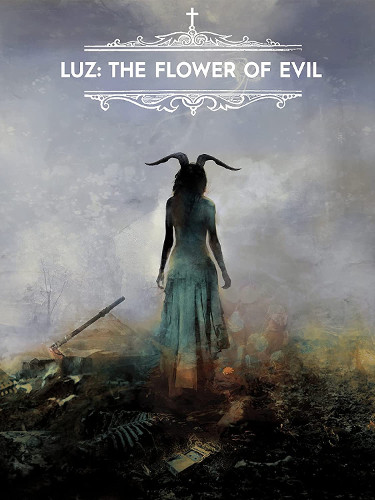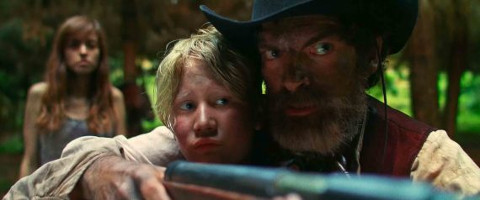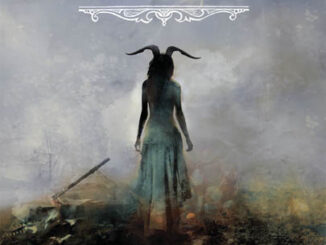Luz: The Flower of Evil (2019)
Directed by: Juan Diego Escobar Alzate
Written by: Juan Diego Escobar Alzate
Starring: Andrea Esquivel, Conrado Osorio, Sharon Guzman, Yuri Vargas
COLUMBIA
AVAILABLE ON DIGITAL NOW, LIMITED EDITION BLU-RAY 23RD AUGUST from FRACTURED VISIONS
RUNNING TIME: 104 mins
REVIEWED BY: Dr Lenera

In the wilderness of Columbia is a small cult. The land is poor and the people are suffering, but their harsh, puritanical leader El Señor tells them that God has spoken to him and they will begin to see miracles. A widower, El Señor has three daughters, Laila, Una, and Zion. Laila, the oldest, comes across a cassette player that her father says is the Devil, though one could almost call El Señor by that name, seeing as, after raping his mother, he keeps a boy chained up in a pen with no food and water, claiming that he’s Jesus – and he’s not the first. Will his brainwashed daughters and any of the other villagers ever see El Señor for who he really is?

She goes into the woods, a place which her father has told her is evil, but where she knows she’ll be able to get away from her tough life for a while. She has with an ’70s-style cassette player, which raises the question as to when this movie is set. It seems like it’s around the turn of the century, but the cassette player suggests a more recent setting. Maybe the village we find ourselves in is like M. Night Shyamalan’s [come on, we all know the twist], which adds an extra dimension to the story. In the player is a cassette of Mozart’s clarinet quintet. She presses play and, immediately entranced by the soothing sounds she hears, spends the rest of the day and even some of the night out there, playing the music over and over again, its beauty mesmerising her and sending her into a different, much nicer world than the one she inhabits. She’s been told by her father that music is the Devil’s work, and that the Devil even lives inside this bizarre, magical device, but surely he’s mistaken. Sometimes she even dances to it with total abandon, perhaps the most Terence Malick-like bit of a film surely influenced by that one-of-a-kind filmmaker, with very similar editing. Perhaps it’s odd that, as I write this review, the scene that sticks most in my mind is one of happiness, of freedom, of joy, despite being in a film which has very little of those things, its characters trapped in a claustrophobic web of torment, guilt and fear. But then it was so great to see this person escape for a while, and anyway isn’t music one of the greatest pleasures in the world?
Juan Diego Escobar Alzate’s debut feature examines what has become quite a familiar subject these days; how extreme faith can be exacerbated by human flaws. But, while one can maybe detect the influence of Ari Aster and Robert Eggers, not to mention not fail to notice a few visual references to no less than one of my all-time favourite filmmakers – no, make that artists – of all time Alejandro Jodorowsky, Alzate brings a lot of his own touches and angles to what could have been a rehash of things we’ve already seen several times before recently, so that he’s produced something that for much of the time manages to feel very fresh. One of his most effective devices, which reinforces the idea of the duality of good and evil as well as adding some irony, is evident in the very opening shots of the locales which are so gorgeous they’re almost too gorgeous, with colour tinting that may seem absurdly bilious if it was employed in a different film. Grass, for example, seems more green than it ever really is, while some shots seem too perfectly composed, as if we’re not seeing reality but a rose-tinted version of it. Yet it’s a huge contrast with the dark, cramped interiors in which it seems like people would go mad even if they didn’t have the issues that they have here, not to mention the growing tension which is bound to periodically erupt in violence of both the mental and the physical kind. By the time we see, for example, an arm with the hand missing [something which the camera lingers on for a hell of a long time] happening outside, it seems so wrong that this horrid sight should exist outside amid such beauty, but then good and evil, while separate concepts, are already mixed up and will become more so. And we did see two grimmer sights in the opening – a bed covered in blood and an animal’s graveyard – juxtaposed with all that resplendent beauty.
The name in the title is actually the name of El Señor’s wife who died two years before, and whose grave is beside a tree which won’t blossom. He’s clearly still traumatised by the event, but we’re not surprised when we find out he beat her, and we never learn how Luz died, so one can’t help but wonder, considering all the other nasty things that he does. His older and only natural daughter Laila has been out walking in the countryside and brings home a tape and tape recorder, but father thinks that ” the Devil does live in the woods and this must be one of his trials”, so he takes the player off her. A dinner scene with him and the three girls speaks volumes; El Señor talks of Luz, how she’s still with them and loves them, but there’s no warmth or tenderness, instead there’s a harsh coldness with an element of fear. That night Laila shows her sisters the tape and says how she thinks an angel is trapped in it, just like Luz once gave them a music box which Luz also said contained an angel. But El Señor tends to see the Devil all over the place and is engaged in a long running battle with him, totally unaware of the irony that much of what he does is on the evil side. He tells the other villagers that God has been talking to him and will soon send a Messiah who’ll make things good, and we have no reason to believe that he doesn’t genuinely think that he’s been communing with the Almighty. But he’s soon revealed to be very nasty indeed when Zion glimpses her father raping a woman right before a chained up child. While we don’t see the act in much detail, us mostly adopting the viewpoint of Zion who doesn’t understand what she’s seeing, the scene has a cruel and nasty power to it, something increased by the innocence of Zion’s voiceover and the religious chorale music. We assume the victim is the boy’s mother, and when we learn that he’s brought boys to the village before, it’s very possible that he did the same things with their mothers too. Why he commits rape we never know, but then we don’t learn much about the boys either.

So what he does is, after they’ve been taken to the creek that feeds their land to baptise them and purify the water, keep them in the chicken coop with an ox yoke round their necks, not even letting them have food or drink, though there is a scene where it appears that this one has been given some food but didn’t eat it, or maybe the food was deliberately placed out of reach in the hope that one of the boys would indeed be the reincarnation of Jesus Christ and either survive or do something magical – I think. Some exact details, just as elsewhere, are a bit vague, but that’s fine I think, especially seeing as El Señor seems to have gone off the deep end some time ago. There are some quite upsetting, if not very long, shots of this latest boy struggling to survive in the cold, though we never see him cry. Johan Camacho in the part isn’t given anything to say, but I think we’re supposed to deduce that the character is in shock. Something that’s especially interesting is the appearance of this possible Jesus, with blonde hair and blue eyes. Jesus has so often been depicted looking like this even though it’s actually very unlikely considering where he was born. Disturbingly, nobody seems to question this awful child abuse, because they’re under the spell of El Señor and believe that anything that he does must be for good. Una has an admirer, Elias, though when they have a liaison in the forest [beginning with him grabbing her throat – sex seems rather joyless in this place] he takes her bleeding as a sign that she’s evil. Uma then falls ill and we immediately know why, but not a single person in the village does.
Everyone seems to be wrongheaded and/or ignorant except for an old guy named Elias who could be more clued in than anyone else though can he really say what we wants? Perhaps there does exist other dissenters, but would they want to go up against El Señor? Conrado Osorio in the part is frightening and dominating even when he’s trying to be nice, and makes us always remember that the character believes that what he’s doing is right even though it clearly isn’t, though the screenplay, also by Alzate, threatens to get almost as lost as El Señor for a short until we reach the climax, some of which is predictable though still has considerable power. Throughout the second two thirds intense and grueling moments increase with a realism that’s perhaps surprising, but then the supernatural is only ever so slightly hinted at, things like a random goat who hangs around sometimes being easily explained away in logical terms. Rooms are very cramped and dark, with people often shot up close and with a hand held camera, while outside we frequently see how vast the world is beyond this isolated village with characters often shown at a distance dwarfed by their surroundings and in very precise compositions with the night sky always full of stars and the moon always full. I suspect that many of these shots used digital assistance to put them together, but the cinematography Nicolás Caballero Arenas is still quite remarkable even though he goes overboard with the black towards the end – realism is fine in a medium where nocturnal scenes often look too bright but when one can’t make out much of the action said realism can go overboard!
Uma and Zion seem to spend much of their time by Luz, praying and hoping the tree will begin to flourish though oddly Laila isn’t seen to go there despite being the only one out of the three who’s her natural daughter. She initially seems like the most together of the three sisters, but some of her actions highly contradict that, while the voiceovers of all three are generally delusional and childlike because of their environment, even they are all a bit different from each other. The three seem to represent grace [Laila], temptation [Uma] and innocence [Zion] respectively but they convince as sisters, Andrea Esquivel, Yuri Vargas and Sharon Guzman all bearing facial similarities to each other and sharing a strong chemistry. Biblical references seem to be frequent right from the beginning with that tape recorder that may as well be an apple. though never feel forced. We’re continually reminded of the potential problems of extreme faith and how evil can come about through the unhealthy handling of emotions and warped perceptions of reality, though what we seem to be seeing more than anything else is are searches for meaning, the character’s minds dominated by notions of good and evil but us being hopeful that they’ll eventually realise that it’s healthier and easier to just embrace life’s unpredictability and inexplicibleness . Whether they do end up doing that could be in the eye of the beholder. It’s not giving too much away that we appear to conclude with what on the surface is some redemption, but do we really? Aided tremendously by a fine music score by Brian Heater based on three main distinct elements; ambient suspense, chorale noodlings and a eerie piano sometimes accompanied a lullaby which enhances the Pan’s Labyrinth feel to some of what we see, Luz: The Flower Of Evil maybe never becomes as profound as it thinks it getsm but is still a very impressive debut from a filmmaker who’s unashamed of showing his influences yet also seems to have quite a unique voice and sensibility, and who I’d like to hear from again soon.
BLU-RAY DETAILS
Limited Edition of 1,000 Units
Collectors’ edition slipcase with new art by Christopher Shy
Collectors’ edition booklet with new writing by Diego López Fernández and Abraham Castillo Flores
Soundtrack CD by Brian Heater
6 Art Cards
Special Features
Audio Commentary with Director and film critic Kurt Halfyard
‘The SITGES Experience’ documentary
‘Making of’ documentary
Trailer Reel
The Scum – Dead Eye’s Music Video
Short Film – The Colours of Hope and Wonder





Be the first to comment